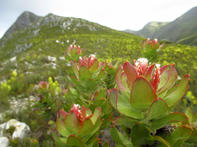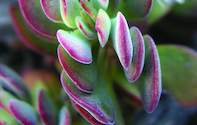A Champion of Fynbos Conservation
Grootbos patriarch, Heiner Lutzeyer, was just as spirited as his two sons who run the place and in his retirement, he went off exploring the property while the next generation built the tourism business.

His curiosity was pricked because the fynbos, while being by a very big margin the smallest of the world's six floral kingdoms, is matched in flowering magnificence only by the Amazon region.
Such is the richness and diversity of this floral kingdom that there are more indigenous plant species in the Western Cape than in all of the Americas and Europe combined. Heiner started asking outside experts to help him make sense of the place's bewildering floral extravagance. The owners of Grootbos themselves became, by and by, fynbos experts and Grootbos Private Nature Reserve became a champion of fynbos conservation and indeed the only place to date that has managed to make these prickly scrublands a sexy tourism destination.
Fynbos is a coy mistress, hiding behind a visage of green-grey foliage for most of the time, but harbouring some 9,000 different flowering plant species in an area about the size of Ireland. Swedish botanist, Carl Linnaeus, was so dazzled by the variety and vast number of plant specimens sent to him from the Cape for classification throughout the 18th century that, although he never visited the place, he called it "this paradise on earth".
Building up Local Impoverished Communities

The Lutzeyers employed a professional fynbos ecologist to oversee the floral side of things, Sean Privett, who has since moved on to head the greater Stanford Conservancy with Grootbos Private Nature Reserve at its heart. Then they started a fynbos nursery and training school in order to provide employment and training for the local impoverished communities.
That has since grown into the Green Futures and Growing the Future projects, that champion fynbos and organic gardening as the roots of a far-reaching community upliftment plan. Most people, even ambitious ones, would have stopped there. When it became clear they could tap into resources they had not previously envisaged, they cooked up a plan to raise donor money in order to build a state-of-the-art sports complex for the needy in nearby Gansbaai fishing village - previously an enclave of smugglers and poachers and now more famous for its great white shark tourism industry. Not bad for a tired old dairy farm that had an appealing view.
By David Bristow Find your happy place at Grootbos Nature Reserve, where you can immerse yourself in the beauty of nature between the mountains, the forest a...
Find your happy place at Grootbos Nature Reserve, where you can immerse yourself in the beauty of nature between the mountains, the forest a... What started out as a hobbity self-catering resort, built to help pay for the restoration of the natural vegetation on a farm near Gansbaai,...
What started out as a hobbity self-catering resort, built to help pay for the restoration of the natural vegetation on a farm near Gansbaai,...